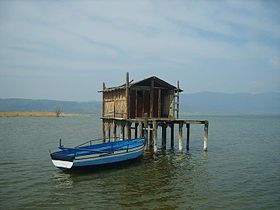- Dojran
-
Dojran (Macedonian: Дојран [ˈdɔjran] (
 listen)) was a city located on the western shore of Dojran Lake in the south-eastern part of the Republic of Macedonia. Today, it is collective name for two villages that exist on the territory of the ruined city: Nov (New) Dojran (settled from the end of World War I to World War II) and Star (Old) Dojran, which contains both old ruins and recent construction, especially hotels, resorts and restaurants. Dojran is located 170 km from Skopje, 59 km from Strumica and some 30km from Gevgelija. The nearest airports are Thessaloniki International Airport and Skopje Airport. Dojran's mayor is currently Risto Gušev. The old city of Dojran was totally ruined during the First world war and after the Second world war the modern villages were established.
listen)) was a city located on the western shore of Dojran Lake in the south-eastern part of the Republic of Macedonia. Today, it is collective name for two villages that exist on the territory of the ruined city: Nov (New) Dojran (settled from the end of World War I to World War II) and Star (Old) Dojran, which contains both old ruins and recent construction, especially hotels, resorts and restaurants. Dojran is located 170 km from Skopje, 59 km from Strumica and some 30km from Gevgelija. The nearest airports are Thessaloniki International Airport and Skopje Airport. Dojran's mayor is currently Risto Gušev. The old city of Dojran was totally ruined during the First world war and after the Second world war the modern villages were established.Contents
History
Dojran, primarily Star Dojran, was first settled in pre-historic times, and the first written record of the city was in the 5th century in which the Greek historian Herodotus, wrote about the Paeonians, ancient Thraco-Illyrian people, who started and expanded the city. Herodotus notes how the Paeonians, lived in settlements accessible only by boats, settlements which still exist today on the west and the north shores of Dojran Lake, in between the cane zones and the lake itself. The economy of Dojran has always been primarily dependent on fishing and success in the business is attributed to the traditional ancient fishing method used by the fishermen.
Ottoman rule
During the Ottoman rule, Dojran developed according to the Turkish model of an Islamic city. The upper part was profoundly impacted by Turkish influence, with narrow streets; whereas the lower part retained its Macedonian roots, crossed with wide streets and modern public buildings. Houses were usually two-storeyed, arranged amphitheatrically, with a view onto the lake. The style of architecture was so similar to that of Salonica that Dojran came to be known as "Small Salonica". The Bazaar, near Dojran Lake, had 300 shops and craft workshops. Many Turkish dignitaries settled there after being stunned by the beauty of the city.
Post-Ottoman time
Dojran is the Macedonian part of the former municipality of Doyuran, which was divided in 1913 by the new borders created between Greece and what was then Serbia. The part at the other side of the border is called Doirani.
World War I devastated the city physically and economically; destroying many cultural monuments and the fishing business. The population was forced to desert the city to escape bombardment. After the war the population returned and formed Nov Dojran. Today the two villages are seen as one town though most new buildings are located in Star Dojran, and are devoted to attracting tourism. The old city had 5000 inhabitants, while under city's control were the neighboring villages and with them the city had 30.000 people.[1].
Architecture
The Amam (Hamam) is a Turkish bath located in the upper part of the city and in the past it was inhabited by the Turkish population. The year it was built is unknown and only parts of the tower remain. The Church of St. Ilija was built in 1874 in the northern part of the city. The current state of the church; fragments of paintings, suggests that the church walls were originally covered with frescos. Dojran is also significant archeologically due to numerous discoveries of accidental or systematic excavations including relief, marble plates with Greek inscriptions, remainders of walls, coins and tombs with epitaphs.
References
External links
- dojran.info - Macedonian.
Coordinates: 41°10′45″N 22°43′29″E / 41.179166666667°N 22.724722222222°E
Categories:- Villages in the Republic of Macedonia
- Greece–Republic of Macedonia border crossings
Wikimedia Foundation. 2010.

